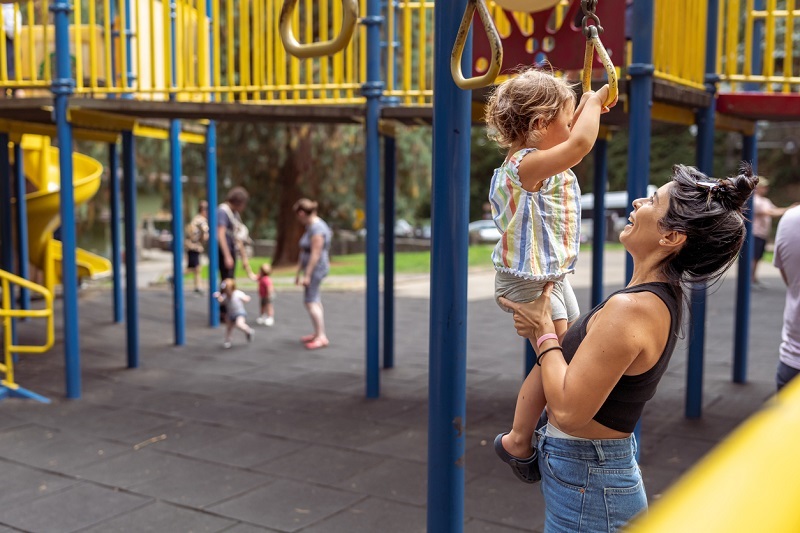Playground Safety: Preventing Common Injuries and Ensuring Child's Well-being

August 28, 2023
Playground time is supposed to be fun, but it sometimes leads to injury. Many of the injuries that occur on playgrounds can be avoided with precautionary measures.
Many playground injuries are caused by misjudgment. Children may be overconfident in their ability to navigate equipment or make risky choices.
“Sometimes, a child doesn’t have enough experience to realize that they can’t do something,” says Frank Cunningham, M.D., a pediatric emergency medicine physician at JFK University Medical Center. “They may copy an older kid’s stunt or simply have too much self-confidence.”
Lack of supervision by parents or guardians also contributes to playground injuries. Adults who closely supervise kids may step in to prevent risky behaviors.
“Younger children who aren’t as confident or coordinated need closer supervision than older kids,” Dr. Cunningham says. “But even older kids need someone to ensure that they climb and play safely.”
About 45% of playground injuries occur because of lack of supervision. Kids may go down slides heard-first or climb onto too-high roof structures.
More than 200,000 children visit emergency departments every year for playground injuries. Read on to learn about common injuries and how to help keep children safe:
Understanding Common Playground Injuries
Falls are the most common category of playground injury. Falls may lead to:
- Cuts and bruises
- Sprains or strains
- Broken bones
- Concussion
- Traumatic brain injury
- Death, in a handful of cases each year
“Young children may get injured when falling from equipment that’s too high for them,” Dr. Cunningham says. “Falling onto the hard ground, not a forgiving surface, may also lead to injury.”
“Parents should also refrain from going down slides with their children on their laps. Frequently, the child’s position may shift and an arm or leg may get twisted between the parent’s body and the slide, resulting in a fracture,” Dr. Cunningham adds.
Other common playground injuries include:
- Burns, when a child sits bare-legged on a hot slide, for example
- Strangulation, when necklaces, sweatshirt drawstrings or jump ropes catch on equipment
- Collisions, when a child crashes into another child or equipment (like a moving swing)
- Entrapment, when a child’s finger, arm, leg or head gets stuck in equipment gaps
“Children don’t necessarily know that metal equipment gets hot, so they may get burned,” Dr. Cunningham says. “Parents may also misjudge situations – having kids wear helmets for safety in this setting, may potentially place the child at risk for strangulation if straps become entangled with certain equipment.”
To Help Your Child Stay Safe on the Playground:
- Choose the right playground. Pick age-appropriate playgrounds, which means smaller equipment and shorter falls for younger kids.
- Opt for safe surfaces. Look for playgrounds with soft and cushioned surfaces beneath the play equipment. Materials that can provide a safer landing for falls include:
- Wood mulch
- Wood chips
- Rubber recycled mulch
- Rubber (or rubber-like) mats
- Sand
- Pea gravel
- Synthetic turf
- Other soft surfaces (not grass, dirt, asphalt or concrete)
- Stay nearby. Be within arm’s reach of preschoolers or within earshot and view of older kids. Your presence should help kids learn to avoid risky behavior and make safe decisions.
- Look for hazards. Clear away or avoid broken glass and other dangerous objects. If playground equipment is broken, don’t use it (and report it to the parks commission).
- Avoid accidental strangulation. Don’t let your child wear necklaces, drawstring hoodies or bike helmets on the playground. Also don’t let kids play with jump ropes while they’re on playground equipment.
- Skip hot surfaces on sunny days. Metal and even dark-colored plastic surfaces may get very hot in the sun. It doesn’t need to be a hot day for a child to get burned.
- Teach your child to play it safe. Show your child the right way to swing, slide and climb when they’re young. Remind older kids that risky playground play may sideline them with injuries.
Next Steps & Resources:
- Meet our source: Frank Cunningham, M.D.
- To make an appointment with a doctor near you, call 800-822-8905 or visit our website.
The material provided through HealthU is intended to be used as general information only and should not replace the advice of your physician. Always consult your physician for individual care.






